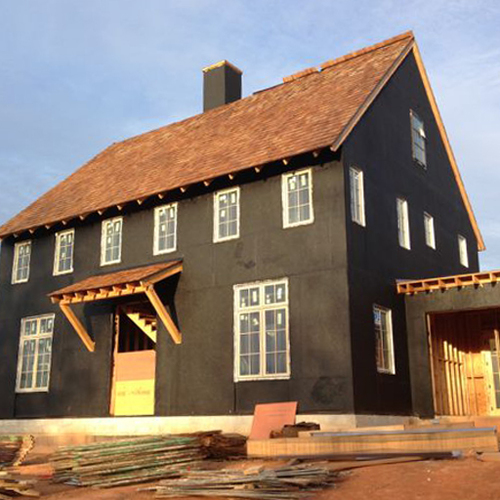
Green builders have been known to get cranky about technical vocabulary, and disputes about word usage sometime erupt online. When discussing air leaks, some authors talk about tightening the home’s “thermal envelope,” while other authors want to tighten a home’s “thermal enclosure.” Before taking sides on issues like this, we need to recognize that some vocabulary disputes matter, while others don’t.
Most of us can agree that our vocabulary choices should reduce ambiguity to a minimum; after all, we want to communicate clearly. This desire for clear, unambiguous communication is one reason that I try to minimize the use of acronyms and abbreviations—although I’ll admit that, like many authors who post on Green Building Advisor, my writing still includes references to OSB (oriented strand board), EPS (expanded polystyrene), and WRBs (water-resistive barriers). On most job sites, a few acronyms are almost unavoidable.
We should also be able to agree that we need to be precise when choosing words that describe building components. Experts who answer questions posted on the Q&A pages of Green Building Advisor sometimes get tripped up by homeowners’ word usage. This can cause the experts to offer advice based on a misunderstanding. For example, sometimes a homeowner’s question includes the word “joist” when “rafter” is intended. This is a case where precise vocabulary matters, because the wrong word can cause readers to misunderstand the type of assembly being described.
When GBA readers debate the merits of “building enclosure” versus “building envelope,” on the other hand, the stakes are rather low. If there is no chance for a misunderstanding, who cares what term you prefer? If you want, go ahead and call it a building enclosure instead of a building envelope. It’s fine with me, as long as we both…
Weekly Newsletter
Get building science and energy efficiency advice, plus special offers, in your inbox.

This article is only available to GBA Prime Members
Sign up for a free trial and get instant access to this article as well as GBA’s complete library of premium articles and construction details.
Start Free TrialAlready a member? Log in















25 Comments
I always loved the British term "Fabric First" defined as "maximising the performance of the components and materials that make up the building fabric itself, before considering the use of mechanical or electrical building services systems." Whenever I used it in my previous job people thought I meant they should put on a sweater.
“The term “vapor control layer” implies that a building needs a continuous vapor control layer (following the analogy of an air barrier). If this were so, a designer looking at elevation blueprints would need to be able to place a pen on one point of this hypothetical layer, and trace the layer in a complete circle, back to its starting point, around the entire building envelope.“
In this paragraph wouldn’t it be accurate to say you ‘trace the layer in a complete circle’ on a “cross section” or “section” of the blueprints rather than the ‘elevation’?
Bar King,
Good catch! My error. Thanks. I've fixed it.
I applaud the care here in complaining about the ones that actually cause trouble while trying to avoid using obscure terminology only to protect the elite status of those who know how to use it.
I think the "needs four control layers" concept would be better phrased as a need for considering four functions. Having the list of four is a good way to avoid forgetting to think through one of them, but I agree that calling them all necessary layers is problematic.
As for pet peeves, mine are thinking that you've indicated a specific kind of plastic when you say "poly," and thinking you've adequately specified a type of insulation by saying "rigid" (There are several different types of foam-board insulation which have important differences in performance and climate impact, as well as other types of boards such as mineral wool).
Oh, and please don't call an electrical receptacle a plug. If you want to call it an outlet, that's fine, but a plug is what you plug into a receptacle. I'm not sure I can justify that one on the basis of impaired communications but I have trouble avoiding being annoyed by it.
Charlie,
Misuse of "plug" bothers me too! Thanks for the contribution.
If you're a real electrician, you call them holes.
https://youtu.be/5etwHVarNgI?t=171
I accept no exceptions to the term, "duplex receptacle." ;-)
I consciously pared down the number of technical and architectural terms I used on construction drawings and specifications when I saw how often it caused confusion for the trades involved. Plain language goes a long way to eliminating misunderstanding.
I tell people that that house needs to be watertight before the cladding is applied.
Building science is complicated, especially for those just getting into it, so anything we can do to make important concepts understandable is helpful. I strongly support the idea of four control layers and disagree that there should be anything confusing about it. Perhaps a way to make everyone happy (yeah, right!) is to specify that cladding is the first line of defense on the exterior, but cladding is rarely if ever watertight.
Michael,
Like you, I don't want confusion.
Right now, the term "vapor control layer" confuses me, which is why it bugs me. Perhaps my brain isn't as nimble as yours. But here's what I figure: if I'm confused, other people on the job site are probably confused, too.
Martin, you make a good point. There is abundant confusion, among architects and engineers as well as builders, about vapor control vs air control vs stormwater control.
Michael,
I agree. And implying (as Joe Lstiburek does when promoting his nomenclature) that creating assemblies that handle vapor diffusion well is a matter of including a "layer" to the assembly does a disservice to the construction community.
It's not about adding a layer. It's about understanding vapor diffusion.
Thinking about this a bit, maybe it's because air and water barriers are more binary:
- "Water on this side does not go on the other side."
- "Air on this side does not go on the other side."
Though the materials performing those duties are not infinitely thin, they are thin enough to be approximated with a line that serves as the delineation.
For both thermal and vapor, it's more of a gradient, and this is harder to reconcile with the idea of a single layer.
It seems like the issue is with 'layers.'
How about:
The 4 environmental elements to manage in wall design.
Or we could expand the list:
The 8 elements to manage in wall design—
1. Structural
2. Bulk/liquid water
3. Air
4. Vapor
5. Thermal (heat)
6. Fire spread
7. Pests
8. Aesthetics
A bit harder to remember an 8 point list. Or to prioritize the order of importance.
Michael,
"Perhaps a way to make everyone happy (yeah, right!) is to specify that cladding is the first line of defense on the exterior, but cladding is rarely if ever watertight."
That's a lot like our code does when mandating rain-screens:
First and Second Planes of Protection
1) Where walls required to provide protection from precipitation comprise cladding assemblies with first and second planes of protection
a) the first plane of protection shall
i) consist of cladding with appropriate trim, accessory pieces and fasteners, and
ii) be designed and constructed to minimize the passage of rain and snow into the wall by minimizing holes and managing precipitation ingress caused by the kinetic energy of raindrops, surface tension, capillarity, gravity, and air pressure differences (see Subsection 9.27.4.)
b) the second plane of protection shall be designed and constructed to (see subsection 9.27.3.)
i) intercept all rain and snow that gets past the first plane of protection, and
Division B: Acceptable Solutions Part 9 – Housing and Small Buildings
British Columbia Building Code 2018 Division B
ii) effectively dissipate any rain or snow to the exterior, and
c) the protection provided by the first and second planes of protection shall be maintained
i) at wall penetrations created by the installation of components and services such as windows, doors, ventilation ducts, piping, wiring and electrical outlets, and
ii) at the interface with other wall assemblies
Man, you guys get all the best code language.
Michael,
Whenever you are ready, it's a short walk from where you are across the border to claim refugee status.
How about 'primary water control layer'. One can have two air barriers, vapor control layers also. Maybe pointing out the one that matters and calling it the primary would be useful? The primary vapor control layer would be the least permeable in the assembly, so on and so forth...
ay ya yai, me duele la cabeza 🤕
Perhaps it is my own misunderstanding of products, but it seemed like for awhile the terms 'self sealing' membrane and 'self adhered' membrane where getting used interchangeably. Are these distinct products?
I also notice BTU and BTU/h as well as kWh and kW getting used quite interchangeably. Usually the context is enough to decipher, but sometimes people are genuinely confused. Notice that heat pump capacities are almost always discussed as 'BTU' when in reality its 'BTU/h.'
Maine Tyler,
You're absolutely right that many HVAC contractors use "BTU" when they mean "BTU/h." This bugs me, too. My high school chemistry teacher, who cared about units, would be tearing out his hair.
"Miles" and "miles per hour" aren't the same.
That one drove me a bit crazy when I started developing a pool solar heating control system as BTU in the common nomenclature made no sense to me. I've rarely, if ever, seen BTU/h specified as it should be. At least with kW and kWh the connection seems logical...as with much of the SI system.
To compound things we get to add in differences like US gallons vs UK gallons so in Canada there is always a question of the 5 gallon bucket's actual volume...and then we scurry about converting that to litres.
Just because it's relevant to the topic of language, not because I'm saying the phrase shouldn't necessarily have been used...
https://www.npr.org/sections/codeswitch/2013/09/19/224183763/is-it-racist-to-call-a-spade-a-spade
An instructive and delightful column. France where I grew up has a very formal and official organization in charge of regulating French language called l’Academie Francaise -it is also one of the country’s favorite topic of mockery.
I could see the point of having an official “construction vocabulary academy” and I would nominate Martin as the person in charge!
Of course France needs l'Academie Française, which serves many important functions -- among them, deciding whether a neologism like "Covid-19" is masculine or feminine.
The ruling: it's feminine, so every educated French citizen now says "la Covid-19." Hearing of the ruling, Stephen Colbert quipped, "We should have known Covid-19 is female. That explains why Trump doesn’t take her seriously."
Log in or become a member to post a comment.
Sign up Log in